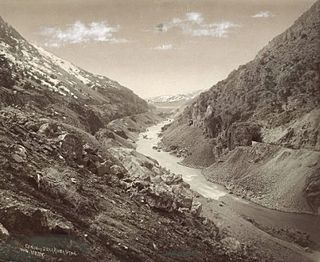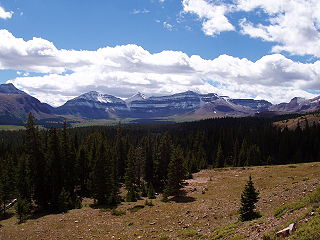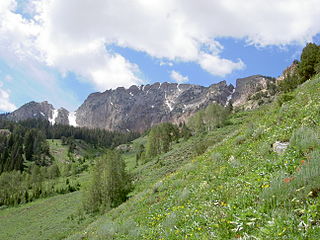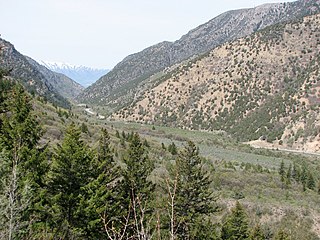| Wasatch-Cache National Forest | |
|---|---|
Cecret Lake in Wasatch-Cache National Forest | |
| Location | Utah / Idaho / Wyoming, United States |
| Nearest city | Salt Lake City, UT |
| Coordinates | 41°39′00″N112°00′54″W / 41.650°N 112.015°W Coordinates: 41°39′00″N112°00′54″W / 41.650°N 112.015°W |
| Area | 1,607,177 acres (6,504.01 km2) |
| Established | August 16, 1906 |
| Governing body | U.S. Forest Service |
| Website | Uinta-Wasatch-Cache National Forest |
Wasatch-Cache National Forest is a United States National Forest located primarily in northern Utah (81.23%), with smaller parts extending into southeastern Idaho (16.42%) and southwestern Wyoming (2.35%). The name is derived from the Ute word Wasatch for a low place in high mountains, and the French word Cache meaning to hide. [1] The term cache originally referred to fur trappers, the first Europeans to visit the land. The Wasatch-Cache National Forest boundaries include 1,607,177 acres (6,504.01 km2) of land.

National Forest is a classification of protected and managed federal lands in the United States. National Forests are largely forest and woodland areas owned collectively by the American people through the federal government, and managed by the United States Forest Service, a division of the United States Department of Agriculture.

Utah is a state in the western United States. It became the 45th state admitted to the U.S. on January 4, 1896. Utah is the 13th-largest by area, 31st-most-populous, and 10th-least-densely populated of the 50 United States. Utah has a population of more than 3 million according to the Census estimate for July 1, 2016. Urban development is mostly concentrated in two areas: the Wasatch Front in the north-central part of the state, which contains approximately 2.5 million people; and Washington County in Southern Utah, with over 160,000 residents. Utah is bordered by Colorado to the east, Wyoming to the northeast, Idaho to the north, Arizona to the south, and Nevada to the west. It also touches a corner of New Mexico in the southeast.

Idaho is a state in the northwestern region of the United States. It borders the state of Montana to the east and northeast, Wyoming to the east, Nevada and Utah to the south, and Washington and Oregon to the west. To the north, it shares a small portion of the Canadian border with the province of British Columbia. With a population of approximately 1.7 million and an area of 83,569 square miles (216,440 km2), Idaho is the 14th largest, the 12th least populous and the 7th least densely populated of the 50 U.S. states. The state's capital and largest city is Boise.
Contents
The Wasatch-Cache was headquartered in downtown Salt Lake City, Utah until August 2007 when its management was combined with the Uinta National Forest and is currently being managed as the Uinta-Wasatch-Cache National Forest. The merged forest is based out of South Jordan, Utah. The Kamas Ranger District was merged with the Uinta National Forest's Heber Ranger District in Heber City. With the newly included Uinta National Forest the forest will expand to 2,487,896 acres (10,068.16 km2). [2]

Uinta National Forest is a national forest located in north central Utah, USA. It was originally part of the Uinta Forest Reserve, created by Grover Cleveland on 2 February 1897. The name is derived from the Ute word Yoov-we-teuh which means pine forest. Because of changes to the boundaries over the years, the Uinta Mountains are now located in the Wasatch-Cache National Forest. In August 2007 it was announced that the Uinta National Forest would merge with the Wasatch-Cache National Forest based in Salt Lake City, Utah, 50 miles (80 km) north of Provo, Utah.

South Jordan is a city in south central Salt Lake County, Utah, 18 miles (29 km) south of Salt Lake City. Part of the Salt Lake City metropolitan area, the city lies in the Salt Lake Valley along the banks of the Jordan River between the 9,000-foot (2,700 m) Oquirrh Mountains and the 12,000-foot (3,700 m) Wasatch Mountains. The city has 3.5 miles (5.6 km) of the Jordan River Parkway that contains fishing ponds, trails, parks, and natural habitats. The Salt Lake County fair grounds and equestrian park, 67-acre (27 ha) Oquirrh Lake, and 27 parks are located inside the city. As of the 2010 Census, its population was 50,418.
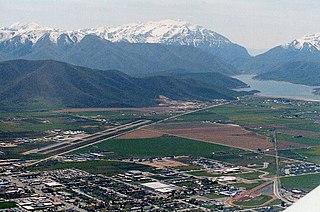
Heber City is a city in northwestern Wasatch County, Utah, United States.
The Cache National Forest portion is located in northern Utah and southern Idaho. It has a land area of 701,453 acres (1,096 sq mi, or 2,838.7 km2). In descending order of land area it is located in parts of Cache, Bear Lake, Franklin, Weber, Rich, Box Elder, Caribou, and Morgan counties. (Bear Lake, Franklin, and Caribou counties are in Idaho, with the rest being in Utah.) There are local ranger district offices located in Logan and Ogden.

The acre is a unit of land area used in the imperial and US customary systems. It is traditionally defined as the area of one chain by one furlong, which is exactly equal to 10 square chains, 1⁄640 of a square mile, or 43,560 square feet, and approximately 4,047 m2, or about 40% of a hectare. Based upon the International yard and pound agreement of 1959, an acre may be declared as exactly 4,046.8564224 square metres. The acre is a statute measure in the United States and was formerly one in the United Kingdom and almost all countries of the former British Empire, although informal use continues.

Cache County is a county on the northern edge of Utah, United States. As of the 2010 United States Census the population was 112,656. Its county seat and largest city is Logan.

Bear Lake County is a county in the U.S. state of Idaho. As of the 2010 United States Census the county had a population of 5,986. The county seat is Paris, and Montpelier is the largest city.
The Wasatch National Forest portion is located in northeastern Utah and southwestern Wyoming. It has a land area of 905,724 acres (1,415.2 sq mi, or 3,365.3 km2). In descending order of land area it is located in parts of Summit, Tooele, Salt Lake, Davis, Uinta, Duchesne, Wasatch, Morgan, Utah, Weber, and Juab counties. (Uinta County is in Wyoming, with the rest being in Utah.) There are local ranger district offices located in Evanston and Mountain View in Wyoming, and in Kamas, and Salt Lake City in Utah.

Summit County is a county in the U.S. state of Utah, occupying a rugged and mountainous area. As of the 2010 United States Census, the population was 36,324. Its county seat is Coalville, and the largest city is Park City.

Tooele County is a county in the U.S. state of Utah. As of the 2010 United States Census, the population was 58,218. Its county seat and largest city is Tooele. The county was created in 1850 and organized the following year.
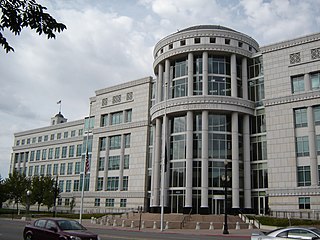
Salt Lake County is a county in the U.S. state of Utah. As of the 2010 United States Census, the population was 1,029,655, making it the most populous county in Utah. Its county seat and largest city is Salt Lake City, the state capital. The county was created in 1850.






